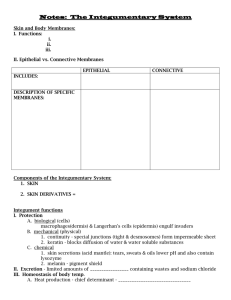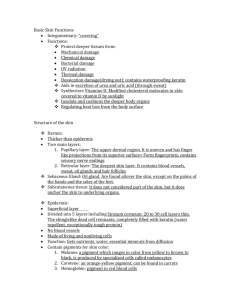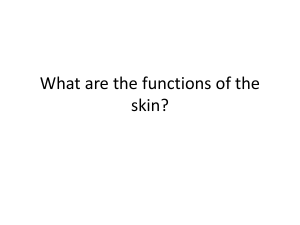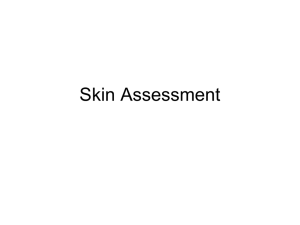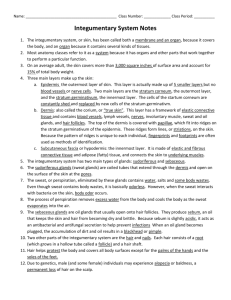Anatomy & Physiology Notes
advertisement
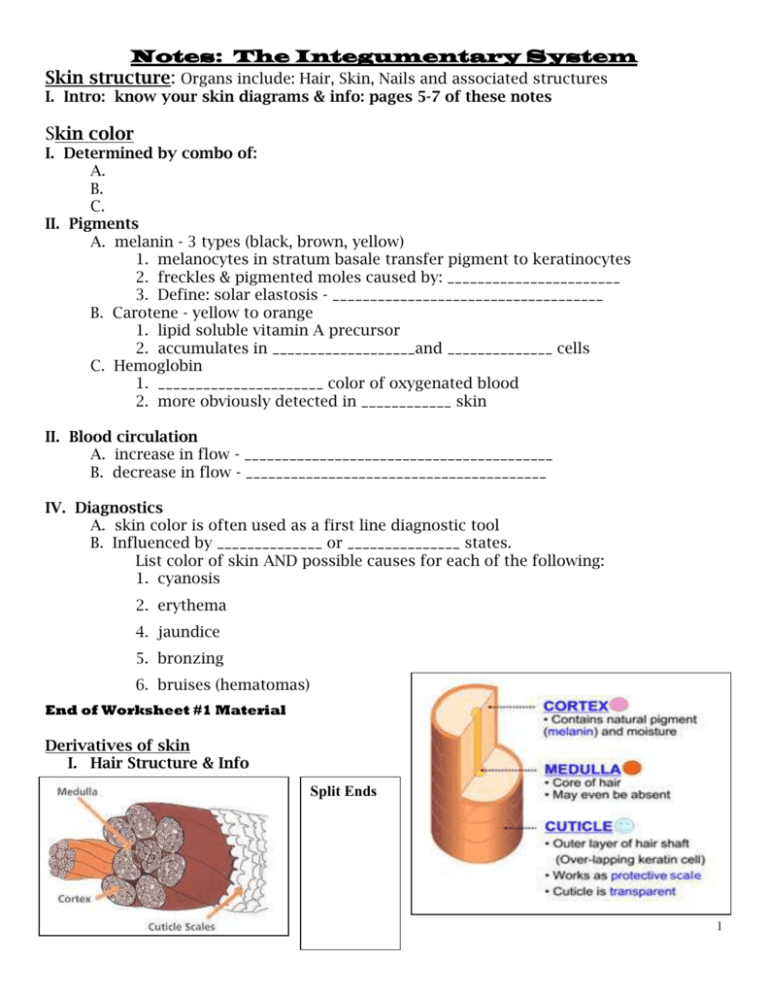
Notes: The Integumentary System Skin structure: Organs include: Hair, Skin, Nails and associated structures I. Intro: know your skin diagrams & info: pages 5-7 of these notes Skin color I. Determined by combo of: A. B. C. II. Pigments A. melanin - 3 types (black, brown, yellow) 1. melanocytes in stratum basale transfer pigment to keratinocytes 2. freckles & pigmented moles caused by: _______________________ 3. Define: solar elastosis - ____________________________________ B. Carotene - yellow to orange 1. lipid soluble vitamin A precursor 2. accumulates in ___________________and ______________ cells C. Hemoglobin 1. ______________________ color of oxygenated blood 2. more obviously detected in ____________ skin II. Blood circulation A. increase in flow - _________________________________________ B. decrease in flow - ________________________________________ IV. Diagnostics A. skin color is often used as a first line diagnostic tool B. Influenced by ______________ or _______________ states. List color of skin AND possible causes for each of the following: 1. cyanosis 2. erythema 4. jaundice 5. bronzing 6. bruises (hematomas) End of Worksheet #1 Material Derivatives of skin I. Hair Structure & Info Split Ends 1 Hair shaft – above skin Hair root – below skin __________________________________ smooth muscle regulated by cold/fright – contraction pulls hair upright causing “goose bumps” _________________________________ actively mitotic area in bulb – directly surrounds papilla _________________________________ capillary know in bulb for hair nourishment __________________________________ expanded deep end of follicule a. Pigment i. caused by proportions of 3 melanin types ii. gray/white hair - melanin replaced by air bubbles in shaft b. hair types i. lanugo ii. vellus iii. terminal c. hair growth i. influenced by: (in this order) 1. nutrition - main influence 2. hormones 3. blood circulation ii. cycles 1. growth phase: actively mitotic vs. resting phase: follicle atrophies 2. scalp - 4 year growth - eyebrows - 3 or 4 months growth iii. baldness ( alopecia ) 1. male pattern baldness - sex linked recessive genetic trait 2. minoxidil - know background, current use, & popularity 3. coarse repl. by vellus - progresses posteriorly 4. thinning – can be caused by medications, nutrition, stress, etc. II. nails - know diagram 2 III. Glands Sebaceous (oil) glands waterproofing softens & lubricates skin and hair Open into ______________________ bactericidal effect secretion stimulated by hormones List imbalance terms in ppt sudoriferous (sweat) glands apocrine glands duct opens into ________________ axillary & anogenital region - begin to function at puberty know sweat composition ceruminous glands (not on diagram) modified apocrine gland external 1/3 of ear canal sudoriferous (sweat) glands. eccrine glands duct opens to __________________ know sweat composition & pH regulated by sympathic NS to assist in ______________________________ Integument functions I. Protection A. biological (cells) macrophages(dermis) & Langerhan's cells (epidermis) engulf invaders B. mechanical (physical) 1. continuity - special junctions (tight & desmosomes) form impermeable sheet 2. keratin - blocks diffusion of water & water soluble substances C. chemical 1. skin secretions (acid mantle): tears, sweats & oils lower pH and also contain lysozyme 2. melanin - pigment shield II. Excretion - limited amounts of _________________ containing wastes and sodium chloride III. Homeostasis of body temp. A. Heat production - chief determinant - ________________________________ B. Heat loss/gain 1. 80% of heat transfer occurs through skin - rest through mucosa 2. regulated by regulating blood flow to skin (vasoconstriction/vasodilation) 3 IV. Vitamin D production - imp. in _____________ uptake from stomach into blood _________________ molecules - when exposed to UV light become inactive vitamin D (precursor) - precursor is modified into active vitamin D in _________________ V. Sensation End of Quiz #2 material Skin cancer basic info I. Incidence - ___________________________________ is main cause of all skin cancers II. Risk factors A. Clothing B. Location C. Skin type D. types of UV 1. UV-A - falls evenly throughout day a. resp. for aging, wrinkling, tanning, depletes collagen, burns cornea b. penetrates deeper - possible immune sys. damage 2. UV - B - falls during midday - resp. for burning – melanoma III. Prevention A. Wear sunscreen whenever outside or cover up B. avoid midday sun between 10-2 and beware of reflected light C. higher altitudes - every 1000 ft above sea level, radiation increases 4-5 % D. Be cautious about tanning beds E. Medications - tetracycline (antibiotics), Retin A, birth control, antidepressants, diuretics, and anti-inflammatories cause photosensitivity F. avoid sunburns G. examine skin regularly - remember ABCD rule – have full body check by dermatologist once a year 4
